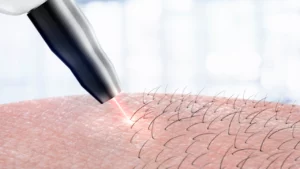Water retention, also known as edema, is common when surplus fluid builds up in the body’s tissues. While mild water retention is often harmless, severe cases can lead to uncomfortable symptoms and indicate underlying health problems. Understanding the common causes and symptoms of water retention is crucial for managing the condition and seeking appropriate medical attention.
So we will delve into what water retention is, how it occurs, and explore its most common causes and associated symptoms. Whether you’re experiencing mild swelling or chronic edema, this guide will provide the knowledge needed to make informed decisions about your health.
What Is Water Retention?
Water retention, also known as edema, happens when surplus fluid accumulates in the body’s tissues, leading to swelling and discomfort. This fluid buildup can occur in any body part, including the hands, legs, feet, ankles, and face.
When the body’s fluid regulation systems are functioning correctly, excess fluid is removed from the body through the kidneys and lymphatic system. However, fluid can accumulate in the body’s tissues when these systems are not working properly. This can be due to various aspects, including hormonal imbalances, certain medications, and underlying medical conditions.
It’s worth noting that some degree of water retention is normal and can occur due to menstrual cycles, hot weather, and prolonged periods of standing or sitting. However, if the swelling is severe or accompanied by other symptoms, seeking medical attention through consultation is essential to rule out any underlying health problems.
Common Causes Of Water Retention
Water retention, or edema, can be caused by various factors. The most common causes of water retention include diet, hormones, medications, and underlying medical conditions.
Dietary factors can play a significant role in the development of water retention. Consuming salt-rich foods can cause the body to retain water, leading to swelling and discomfort. Additionally, a diet that lacks sufficient protein can lead to low levels of albumin in the blood, which can also contribute to fluid buildup in the body’s tissues.
Hormonal imbalances, such as those during menstruation or pregnancy, can also induce water retention. Fluctuations in estrogen and progesterone levels can affect the body’s fluid balance, leading to swelling in the body’s hands, feet, and other areas.
Certain medications can also contribute to water retention, such as those used to address high blood pressure or nonsteroidal anti-inflammatory drugs (NSAIDs). These medications can interfere with the body’s ability to regulate fluid balance, leading to edema.
Underlying medical conditions such as heart, liver, or kidney disease can also cause water retention. These conditions can impair the body’s ability to remove excess fluid, leading to swelling and discomfort.
Symptoms Of Water Retention
Water retention, or edema, can cause various symptoms depending on the rigor and location of the fluid buildup. Some of the most common symptoms of water retention include:
- Swelling – Swelling in the affected area is one of the most common symptoms of water retention. This can be mild or severe, hanging on the fluid buildup.
- Weight gain – Water retention can cause a sudden increase in weight as the body retains excess fluids.
- Stiffness – Joint swelling can cause stiffness and discomfort, making moving difficult.
- Changes in skin texture – Water retention can cause the skin to become tight and shiny or dimpled and pitted.
Other symptoms of water retention can include shortness of breath, abdominal pain, and a general feeling of discomfort or malaise.
Mild water retention is often harmless and can be managed with lifestyle changes, such as receding salt intake and increasing physical activity. However, if the symptoms are severe or accompanied by other symptoms, seeking medical attention is essential to rule out any underlying health problems.
How It Is Treated
When managing water retention, a range of treatment options are available, depending on the underlying cause and severity of the condition. One innovative and non-invasive treatment option is Lymphastim.
Lymphastim is a medical device that uses pneumatic compression therapy to stimulate lymphatic drainage and improve circulation. This treatment can help to reduce swelling, improve mobility, and alleviate discomfort associated with water retention.
During a Lymphastim treatment, the patient wears inflatable boots or sleeves attached to a control unit. The control unit then inflates and deflates the boots or sleeves in a specific sequence, applying gentle pressure to the affected area and encouraging lymphatic drainage.
One of the benefits of Lymphastim is that it is a non-invasive treatment option that can be used alongside other treatment methods, such as medication and lifestyle changes. It is also a safe and effective treatment option for individuals who cannot undergo more invasive treatments, such as surgery.
Not A One-Time Fix
While Lymphastim can be an effective treatment option for managing water retention, it’s important to note that it’s not a one-time fix. A 45-90 minute session should be repeated once every 1-2 weeks to see the best effects.
Consistency is pivotal when it comes to managing water retention with Lymphastim. By repeating treatments regularly, patients can maintain the benefits of improved lymphatic drainage and circulation, reducing the risk of fluid buildup and associated symptoms.
In addition to Lymphastim, a range of other treatment options are available for managing water retention. Lifestyle shifts such as reducing salt intake, increasing physical activity, and wearing compression stockings can help to reduce swelling and improve circulation.
In some cases, medication may also be defined to manage water retention. Diuretics, or water pills, can help to remove excess fluid from the body. At the same time, medications that regulate hormone levels can be used to manage hormonal imbalances that contribute to water retention.
Takeaway
If you’re experiencing water retention and looking for effective and non-invasive treatment options, Lymphastim may be a suitable option. At Isya Aesthetics, our experienced professionals can help you explore the best treatment options for managing water retention and other related conditions.
Contact us today to understand more about our Lymphastim treatments and other services to help you achieve optimal health and wellness. Our team is dedicated to providing personalized and compassionate care to help you look and feel your best. Don’t let water retention hold you back – take the first step towards relief and contact us at Isya Aesthetics today.







